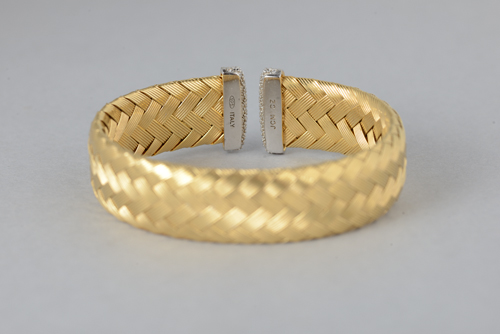Focus Stacking to Photograph Jewelry
Jewelry is known to be one of the most difficult art forms to photograph. At art shows, aside from it being the most populated and competitive medium to jury in, the small size of most pieces makes it very difficult to photograph, especially trying to keep the entire piece in focus. Usually any angle except shooting straight on results in the back of the piece going out of focus. Using autofocus makes it worse. The way autofocus works is that it focuses on the closest part of an object that is within the focus range of a lens. That’s why lenses used for photographing jewelry should be set for manual focus and the focus should be closer to half way between the front and back of the piece. Sometimes even that is a delicate balance and might require moving the lens further away and cropping.
Not wanting to waste pixels, I photograph jewelry (and all the artwork I photograph) with a high megapixel DSLR and macro lenses, coming close to filling the frame with the object. Macro lenses are usually the sharpest and most corrected (least amount of distortion) lenses a manufacturer makes and are designed for close focusing and copy work. I’ve been using Zeiss macro lenses, heavy manual focus macro lenses that make focusing really easy because of the long throw from minimum focus to infinity and relatively tight focus movement when rotating the lens barrel.
Most of the time, depending on the position and intensity of the lighting, I end up stopping the lens down to F22 for maximum depth of field. But I sometimes still struggle, depending on the angle, to keep the entire piece in focus, especially with rings or bracelets photographed from an interesting angle.
Just recently I started experimenting with focus stacking software. What focus stacking software does is combine multiple images, each focused on a different part of the piece, resulting in a single image that is entirely in focus and very sharp.
Another benefit of focus stacking is that you can use the lens at at aperture that creates a sharper image. All lenses have an aperture that is optimum, usually a few stops down from wide open, usually somewhere between F4 and F8. Stopping down to F16 or F22 starts to introduce diffraction, which causes the image to be slightly blurred due to the bending of the light rays through the narrow aperture of the lens. Be aware that the slight softness caused by diffraction is usually not visible in the resulting image. It’s more theoretical. But for these example images I’ve provided, I was able to shoot at F8, instead of the F22 I usually shoot at.
I originally photographed the bracelet in eight images, each focused at a different place. Besides the example images on this page, you can download a zip file of all eight larger images, large enough to see the areas that are in focus.
More articles on photographing your own art
Examples of my jewelry (and other artwork) photography
The software I used for these images is called Zerene Stacker. I downloaded a trial version to experiment with and have since purchased it.





